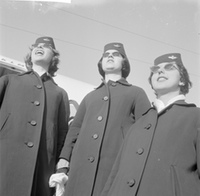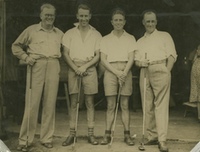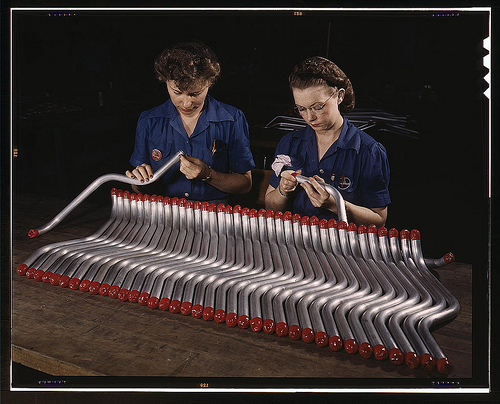
For a long time, CafePress was the major player in customized product creation on the Internet. Slowly other sites sprang up, like Zazzle, Skreened, StickerGiant, Lulu, and many more. Many of these options are novelty one-offs, though, and you’re paying for the customization, not the craftsmanship, of the product. But the success of these somewhat kitschy sites have revealed a real hunger in consumers for customized, personalized products, and a new wave of entrepreneur is capitalizing on this trend to bring customization to chocolate, men’s dress shirts, and a whole lot more.
I’ve been exchanging emails with a number of these entrepreneurs about their products, asking them all the same questions: how and why? All of them are building something that someone wants: not a one of these folks is trying to create a market where no demand exists. Many of them are also trying hard to democratize the entire purchasing process, and working to undo the homogenization of mass-produced products.
Think for a moment how subtle customization is a part of your every day life. Movies on demand at Netflix allow you to watch what you want to watch, not what the programming director at some cable channel feels like airing. You can put together specific playlists of only songs you actually want to hear, instead of what the radio broadcasts. You can order that Big Mac without onions, and get a shake instead of a soda with your value meal. Your computer is customized, your iPod is the color you want it and connected to the headphones you like the best, and on and on. How many of your decisions every day are the result of your specific decision to customize the things around you? And yet, you buy your clothes off a rack…
 No better example of the problem of homogenization exists than clothing. Factories churn out millions of garments every day, all in the “standard” sizes in order to maximize profit while minimizing cost and effort. But really, how well do the standard sizes fit you? I’m a tall, lean fellow, so XL is just a shade too small and XXL is too baggy. We’ve all grown up accustomed to poorly fitting garments. Not everyone has the means to connect with a tailor to get really good fitting clothing, and others see it as an expense that can’t be justified: we’ll just live with the standard sizes and make peace with the fact that our sleeves are a little too short and the collar a little too tight.
No better example of the problem of homogenization exists than clothing. Factories churn out millions of garments every day, all in the “standard” sizes in order to maximize profit while minimizing cost and effort. But really, how well do the standard sizes fit you? I’m a tall, lean fellow, so XL is just a shade too small and XXL is too baggy. We’ve all grown up accustomed to poorly fitting garments. Not everyone has the means to connect with a tailor to get really good fitting clothing, and others see it as an expense that can’t be justified: we’ll just live with the standard sizes and make peace with the fact that our sleeves are a little too short and the collar a little too tight.
So it’s little surprise that three of the entrepreneurs with whom I’ve communicated are working to make custom-fitted clothing easier to design and purchase. Danny Wong of Blank Label tells me that Blank Label started as a pretty traditional custom tailor shop: they’d come to your office, measure you up, show you a book of swatches, and worked up a dress shirt or suit for you. Eager to try something new, but still leveraging their existing supply chain, they embarked on the design-it-yourself path. Wong observes that demand for customization permeates our everyday lives:
One big factor is a shift in consumer demand. With products and services like iTunes and Pandora where you pick and choose your own music, BK’s “have it your way” motto, Build-a-Bear’s create-your-own teddy bears, consumers are hungry to get product personally made for them and designed by them.
Peter Crawfurd and Michael Yang from ShirtsMyWay quickly came to the obvious conclusion that they “could bring it up to another level with the internet”:
There is the whole aspect of being able to design your own shirts and preview which wouldn’t be possible in the offline world. It is also convenient for customers to get their shirts delivered to their door and then when they need new shirts they’ll just go in and order more and get the same great fit.
I asked Seph Skerritt of Proper Cloth if dress shirts were an intentional decision for him, or if it came as the result of an iterative process:
Yes, we specifically set out to do shirts. It did not evolve that way.
I like the dress shirt category because I believe finding a good fitting dress shirt off-the-rack is difficult for a lot of people. Technically, it’s easy to understand why. Dress shirts have several fit-points that are all critical (collar size, sleeve length, chest/waist size, length). If the sleeves are an inch too long or too short, it will be noticeable and if the collar is too tight, you’ll be very uncomfortable. Furthermore, dress shirts are made from woven cotton with little stretch, leaving little room for error. The result is that standardized sizes (small, medium, large, etc) frequently do not meet customer’s demands. With more tailored/fitted looks in fashion, this becomes even more of an issue. With the growth of e-commerce and improvements in manufacturing/supply chain capabilities, I think there’s a huge opportunity to disrupt the established industry with a made-to-order business model.
An interesting twist on customized clothing comes from Nicholas Marx of Bespokeable, currently in closed beta: a marketplace for customized products backed by a recommendation engine. Bespokeable is currently focusing on clothing, but they have plans to expand to other customized goods.
I did specifically set out to build the recommendation engine that powers the personal outfitting service. However, the idea to turn over the production to actual tailors and build a marketplace was indeed the result of an iterative process. The original idea of Bespokeable was actually a clothing line. In a nutshell, we’re zigging, where everyone else is zagging.
The Bespokeable recommendation engine, according to Marx, will benefit both buyers and sellers:
We take certain data from the buyers such as their hair, eye, & skin color (amongst others) to be used to recommend certain fabrics that will look best with each person. We think that it’s this dedicated focus on personalization that will make the buyers want to use Bespokeable’s market. Bespokeable’s system also gets better for buyers each time they uses it. When someone buy something on Bespokeable, we use that data to recommend future items to that same person as well as to other people who are like that person. This actually acts as an incentive for the buyers to go through Bespokeable, which in turn is an incentive for the sellers to stay on our system…
Certainly there’s a price premium imposed on customized clothes. But the old adage “you get what you pay for” may never have been more appropriate. You can pay a little for mass-produced goods made from cheap materials and assembled as quickly as possible; or you can pay a bit more for a quality garment that’s made from good material by a real human being with an eye for detail. Marx opines about the future of craftsmanship and customization:
It’s also worth noting that it’s independent craftsmen who are best suited to meet the increase in demand for one-off products, not large factories that are designed for mass-production. If you think about it, the clothing industry hasn’t really changed since the Industrial Revolution. Perhaps this “customized micro-production revolution” will be the Second Industrial Revolution.
 The trend toward customization extends far beyond custom clothing, though. In addition to Chocri for custom chocolates, there’s also Chocomize, founded by Eric Heinbockel, Nick LaCava, and Fabian Kaempfer. Customized chocolate was a ripe opportunity for business because, according to their research, chocolate is a relatively recession-proof luxury good and customers were becoming increasingly demanding when selecting premium chocolates. Despite America’s sweet tooth, there are still some hurdles for Chocomize and its peers to overcome.
The trend toward customization extends far beyond custom clothing, though. In addition to Chocri for custom chocolates, there’s also Chocomize, founded by Eric Heinbockel, Nick LaCava, and Fabian Kaempfer. Customized chocolate was a ripe opportunity for business because, according to their research, chocolate is a relatively recession-proof luxury good and customers were becoming increasingly demanding when selecting premium chocolates. Despite America’s sweet tooth, there are still some hurdles for Chocomize and its peers to overcome.
The biggest challenge that we see in this space is simply that Americans are still unfamiliar with the concept of co-creation on this scale. Americans take for granted that their computers are customizable or their cars are customizable during the shopping process but they are unaware of the ability to customize other, smaller purchases particularly food. While we have been very successful at getting our own brand name out through national outlets like Oprah Magazine, the Costco Connection, or Reuters our companies have to both educate consumers about the co-creation process and then educate the consumer about the specific brand.
 A bit more discussion with other entrepreneurs in the customization space confirms that it’s still focused largely on luxury goods, or higher-end products. For example, Brad Lindenberg is pushing customized golf clubs at his site Lind Golf. You don’t need golf clubs, in, say, the same way you do need decent clothing, so Lind Golf is targeting dedicated golfers. Visitors can get a perfectly fitted golf club for their height and swing, and now have it laser etched for more visible personalization.
A bit more discussion with other entrepreneurs in the customization space confirms that it’s still focused largely on luxury goods, or higher-end products. For example, Brad Lindenberg is pushing customized golf clubs at his site Lind Golf. You don’t need golf clubs, in, say, the same way you do need decent clothing, so Lind Golf is targeting dedicated golfers. Visitors can get a perfectly fitted golf club for their height and swing, and now have it laser etched for more visible personalization.
We manufacture our golf shafts, grips and ferrules in 9 different colors and offer over 20 shaft and grip upgrade options to customers (allowing for over 50 million possible combinations of clubs). The internet model means we can stock all our equipment in component form and assemble our gear only when an order comes in. This means we can make a club in left hand, minus 1/2 inch with a red shaft, black grip and red club head and ship it out the very next day. A retail store cannot offer this level of customization and turn it around so quickly.
I’m not a golfer, but the golfers I know do take their activity pretty seriously. If you’re going to spend the time and money to play with any regularity, I’d assume you’d want equipment that was comfortable to use and performed well. Customization of clubs pretty obviously addresses that.
There are, of course, lots of other sites offering lots of unique customized luxury products. We’ve covered Shapeways, the customized fabrication shop, a number of times before, and they keep rolling out new products and new materials. There’s also Fluid Forms where you can create customized belt buckles, streetmap clocks, and more. All of these are things to enhance your home or to make a really unique gift, rather than address commodity needs.
Rounding out the entrepreneurs with whom I spoke is Arwa Jumkawala, creator of Gemkitty, where you can design customized jewelry for that special someone in your life.
There’s always been custom work in fine jewelry, but it tends to get very expensive, difficult, and time consuming. Having been in the gem and jewelry trade my whole life, I thought there was a huge opportunity to take that process, democratize it, and just make it easier.
Gemkitty launched last fall, and while they don’t have a lot of repeat business yet, Jumkawala tells me they’ve also not yet had any returns of their products, which I think is a real testament to the quality of their creations, and how meaningful it is to the recipient.
One of the most interesting things, to me, to learn from these discussions about customization is the level of fraternization amongst many of the people in this space. Several of the folks quoted in this piece contacted me on their own and helpfully included in their opening emails links to their peers doing customization in other areas. Certainly there’s a level of competition — Blank Label, Proper Cloth and ShirtsMyWay are all courting the same clients, basically — but they’re all cognizant of this fact, and speak highly of one another. Each feels confident that they can compete on their own and remain relevant in this burgeoning aspect of e-commerce. ShirtsMyWay is touting their seven trillion combinations, but their products are made in Asia; while Proper Cloth makes all of their shirts in the U.S., which may be an important consideration for some shoppers.
In some ways, a lot of these customization offerings are the logical progression of e-commerce, and we can likely expect a growing ecosystem of customized products available for purchase. Clothing and jewelry and golf clubs all make sense to personalize. Will we ever be able to design our own toilet paper patterns, or screwdriver handles, or silverware? Would we ever need to?

